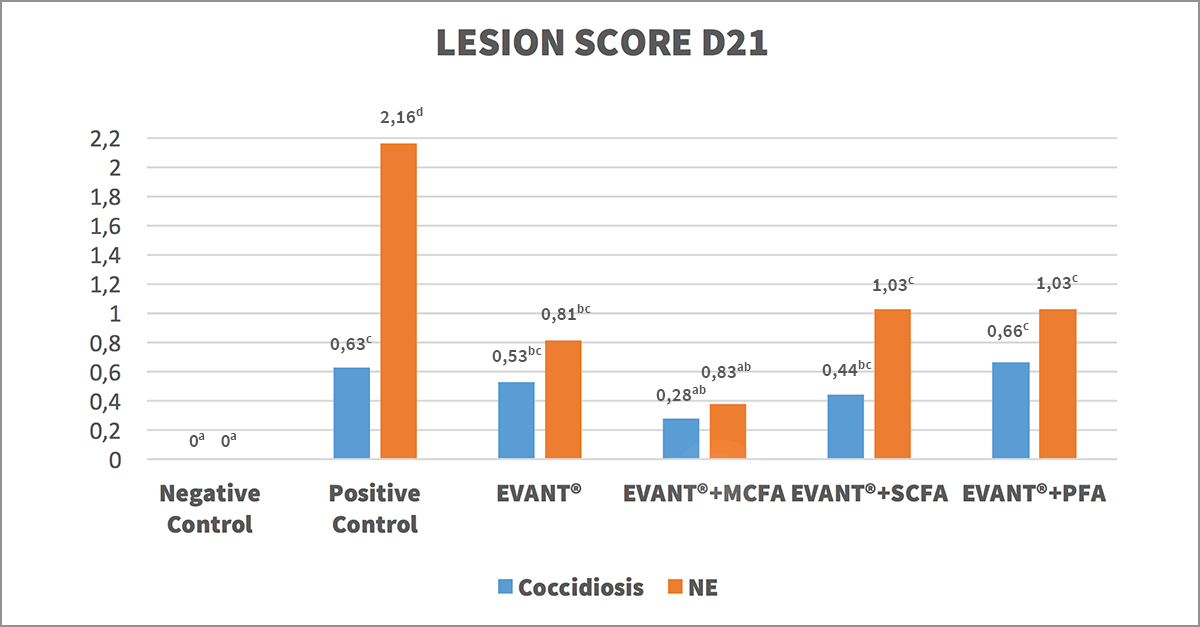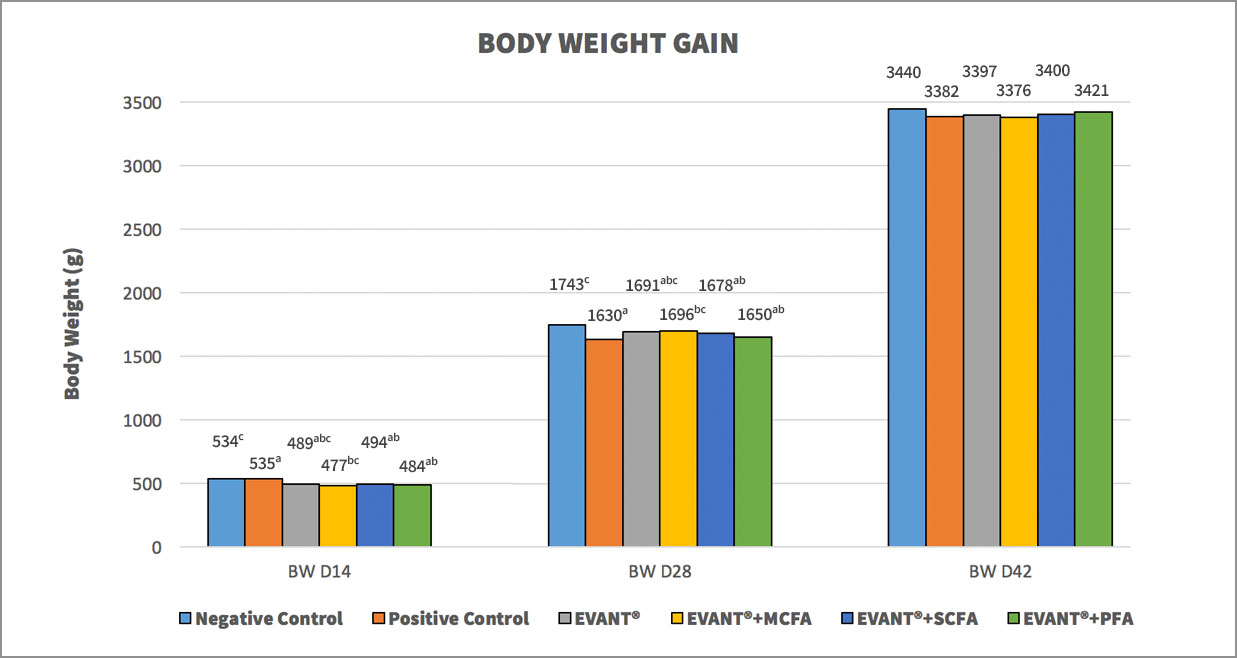Even if symptoms of coccidiosis in chickens are not the only predisposing factor to necrotic enteritis, they are probably the most common due to the widespread presence of the disease in commercial poultry.
In our previous post we described the hypotesis of a composite approach with the use of attenuated coccidiosis vaccines and feed additives in order to control the problem of necrotic enteritis (NE) in broilers.
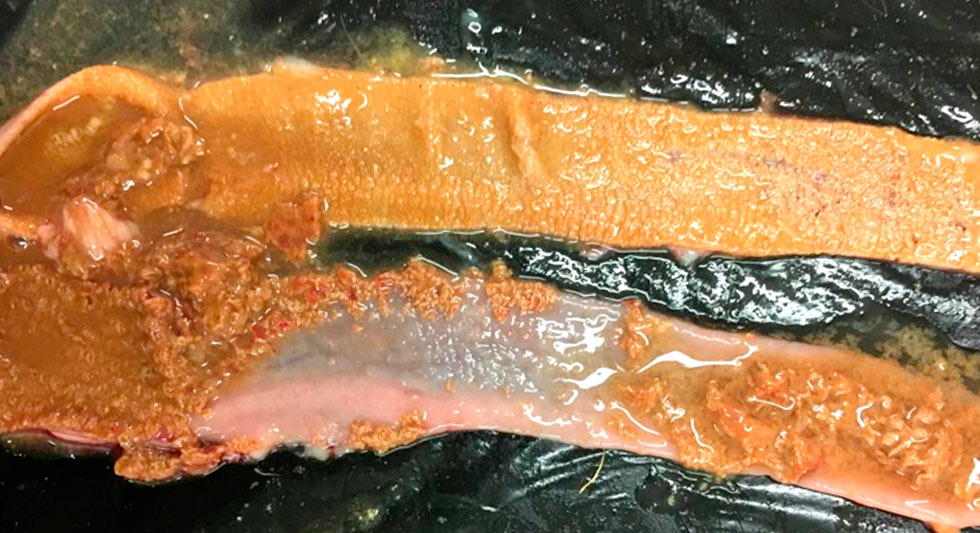 NE lesions in the positive control group after challenge
NE lesions in the positive control group after challenge
In order to do so, we set up an experimental trial to test the efficacy of an attenuated coccidiosis vaccine in combination with different feed additives in preventing the loss of production performance and intestinal lesions in broilers challenged with NE.
In the present post, we will show the results of the trial.
Symptoms of coccidiosis in chickens and NE evaluation: mean intestinal lesion score, mortality, productive performances and oocyst excretion in the faeces
The experimental NE challenge in the positive control group of birds showed a slight but not significant increase in mortality and a significant increase in intestinal lesions associated with symptoms of coccidiosis in chickens with E. maxima and also with C. perfringens (Graphics 1 and 2).
Vaccine administered alone or in combination with feed additives in the diet significantly decreased the intestinal lesion score associated with C. perfringens and slightly but not significantly the mortality compared to the untreated group; the lack of significant differences in mortality was probably due to the high variation (Graphic 2).
The MCFA supplemented group was the only one which showed a synergistic effect with the vaccine; thus, a further statistically significant decrease in the intestinal lesion score associated with C. perfringens was observed.
 Graphic 6. Eimeria spp. oocyst excretion in faeces. Results are reported as number of oocysts per gram (OPG).
Graphic 6. Eimeria spp. oocyst excretion in faeces. Results are reported as number of oocysts per gram (OPG).
The effect on body weight (BW) due to NE and symptoms of coccidiosis in chickens was seen shortly after the challenge (Graphic 3).
The disease reduced the growth of the birds as demonstrated by the lower body weight (BW) and higher feed conversion ratio (FCR) (Graphic 4).
The main effect of the disease on the productive performances was observed at 28 dpv and growth losses were compensated by birds afterwards but with less efficiency (Graphics 3-4).
After the NE challenge, the vaccinated groups grew and converted feed better than the positive control group as shown by the higher BW and lower FCR (Graphics 3-4).
A compensatory growth after the challenge (28-42 dpv) was probably the cause of the observed lack of significant benefits on this parameter at 42 dpv (Graphic 3).
The supplementation of the diet with feed additives did not further improve the body weights of the vaccinated birds after the NE challenge (28 dpv) compared to the vaccine alone; thus, no statistically significant differences in those parameters were found (Graphic 2).
However, the group with MCFA was the only one among those vaccinated and with a diet supplemented with additives which converted the feed more efficiently, as shown by the lower FCR in the overall period (Graphic 5).
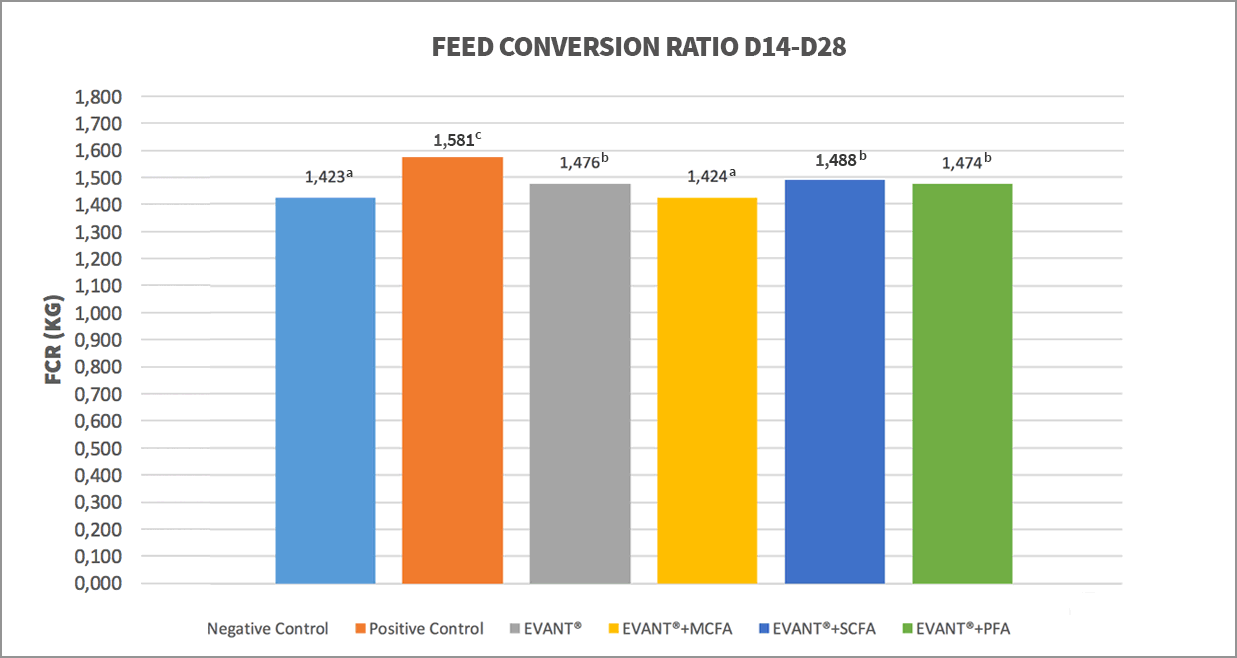 Graphics 4 & 5: Feed Conversion Ratio D14-D28 vs Feed Conversion Ratio D0-D42.
Graphics 4 & 5: Feed Conversion Ratio D14-D28 vs Feed Conversion Ratio D0-D42.
The number of oocysts excreted in fresh faeces was counted to check the vaccination as well as the challenge performances (Graphic 6).
In fact, the oocyst count is a method routinely used as a parameter to evaluate the presence of challenge, together with the symptoms of coccidiosis in chickens.
The period between 5 and 7 dpv, and 14 dpv generally corresponded to the excretion of the vaccine’s attenuated strains during the first and second replication cycles respectively.
The vaccinated groups showed excretion of certain levels of oocysts during that period, indicating a successful vaccination process.
After the challenge (21 dpv), oocyst excretion greatly increased in the challenged groups, which was consistent with the replication of the inoculated E. maxima.
The non-vaccinated and challenged group showed the highest levels of oocyst excretion. On 28 dpv, the oocyst excretion was low in all treatments and without significant treatment effects.
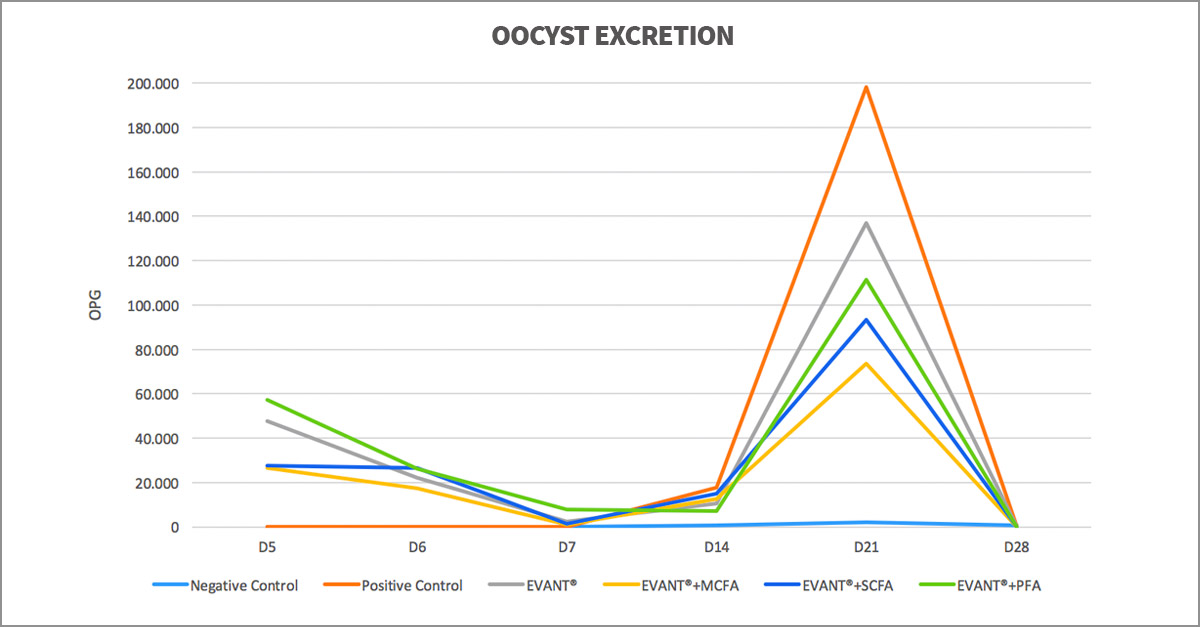 Graphic 6. Eimeria spp. oocyst excretion in faeces. Results are reported as number of oocysts per gram (OPG).
Graphic 6. Eimeria spp. oocyst excretion in faeces. Results are reported as number of oocysts per gram (OPG).
Preventing symptoms of coccidiosis in chickens is key in the fight against NE
In this study, vaccination with EVANT®, an attenuated coccidiosis vaccine for broilers, was shown to be able to reduce intestinal lesions associated with NE and also the symptoms of coccidiosis in chickens.
Intestinal lesions associated with C. perfringens were reduced compared to non-vaccinated birds and, as a consequence, benefits in productive performances were observed as well.
Feed conversion was improved compared to non-vaccinated birds during the critical period of the disease. The supplementation of SCFA- and PFA- based feed additives in the diet of vaccinated birds did not provide more benefits than the vaccine alone.
MCFA were shown to be able to further decrease intestinal lesion scores associated with C. perfringens than vaccination alone, and a significant improvement in the feed conversion efficacy was observed.
In conclusion, vaccination with EVANT® reduced the intestinal lesions caused by NE disease triggered by E. maxima, a predisposing diet and C. perfringens infection (Williams et al., 2003; Williams et al. 2005); therefore, it also prevented some of the productivity losses associated with the disease.
Supplementation of MCFA to the diet of vaccinated birds further reduced the intestinal lesions caused by the same NE challenge model compared to vaccination alone and improved the feed conversion of birds regardless of the NE challenge.
References:
- Williams R.B., Marshall R.N., La Ragione R.M., Catchpole J., 2003. A new method for the experimental production of necrotic enteritis and its use for studies on the relationships between necrotic enteritis, coccidiosis and anticoccidial vaccines of chickens. Parasitol Res. 90: 19-26.
- Williams R.B., 2005. Intercurrent coccidiosis and necrotic enteritis of chickens: rational, integrated disease management by maintenance of gut integrity. Avian Pathol. 34, 159-180.

